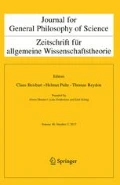Abstract
The question whether Kuhn's theory of scientific revolutions could be applied to mathematics caused many interesting problems to arise. The aim of this paper is to discuss whether there are different kinds of scientific revolution, and if so, how many. The basic idea of the paper is to discriminate between the formal and the social aspects of the development of science and to compare them. The paper has four parts. In the first introductory part we discuss some of the questions which arose during the debate of the historians of mathematics. In the second part, we introduce the concept of the epistemic framework of a theory. We propose to discriminate three parts of this framework, from which the one called formal frame will be of considerable importance for our approach, as its development is conservative and gradual. In the third part of the paper we define the concept of epistemic rupture as a discontinuity in the formal frame. The conservative and gradual nature of the changes of the formal frame open the possibility to compare different epistemic ruptures. We try to show that there are four different kinds of epistemic rupture, which we call idealisation, re-presentation, objectivisation and re-formulation. In the last part of the paper we derive from the classification of the epistemic ruptures a classification of scientific revolutions. As only the first three kinds of rupture are revolutionary (the re-formulations are rather cumulative), we obtain three kinds of scientific revolution: idealisation, re-presentation, and objectivisation. We discuss the relation of our classification of scientific revolutions to the views of Kuhn, Lakatos, Crowe, and Dauben.
Similar content being viewed by others
REFERENCES
Arnold, V. I.: 1974, Mathematical Methods of Classical Mechanics, Springer-Verlag, New York.
Crowe, M.: 1975, Ten ‘laws’ concerning patterns of change in the history of mathematics, Historia Mathematica 2, pp. 161–166. Reprinted in: Gillies, 1992a, pp. 15–20.
Crowe, M.: 1990, Theories of the World from Antiquity to the Copernican Revolution, Dover, New York.
Dauben, J.: 1984, ‘Conceptual revolutions and the history of mathematics: two studies in the growth of knowledge’, in: E. Mendelsohn (ed.), Transformation and Tradition in the Science, pp. 81–103, Cambridge University Press. Reprinted in: Gillies, 1992a, pp. 49–71.
Gillies, D. (ed.): 1992a, Revolutions in Mathematics, Oxford, Clarendon Press.
Gillies, D.: 1992b, The Fregean revolution in Logic, in: Gillies, 1992a, pp. 265–305.
Giorello, G.: 1992, The “fine structure” of mathematical revolutions: metaphysics, legitimacy, and rigour. The case of the calculus from Newton to Berkeley and Maclaurin. In: Gillies, 1992a, pp. 134–168.
Gray, J.: 1979, Ideas of Space, Euclidean, non-Euclidean, and Relativistic, Clarendon Press, Oxford.
Gray, J.: 1992, The nineteenth-century revolution in mathematical ontology. In: Gillies, 1992a, pp. 226–248.
Jones, Ch. K. R. T.: 1995, Geometric Singular Perturbation Theory, in: Johnson, R. (ed.), Dynamical Systems. Lecture notes in mathematics vol. 1609, Springer-Verlag, Berlin.
Kuhn, T. S.: 1962, Structure of Scientific Revolutions, University of Chicago Press.
Kvasz, L.: 1996, Was bedeutet es, ein geometrisches Bild zu verstehen? Ein Vergleich der Darstellungsweisen in der euklidischen, projektiven und nichteuklidischen Geometrie, in: Reichert, D. (ed.), Raümliches Denken. vdf Hochschulverlag an der ETH Zürich, pp. 95–122.
Kvasz, L.: 1998a, On Idealisation in Science and in Mathematics, an Analogy between the Pythagorean and Galilean Scientific Revolutions. Submitted to Philosophy and Phenomenological Research.
Kvasz, L: 1998b, The changes of language in the development of mathematics. Submitted to Philosophia Mathematica.
Kvasz, L.: 1998c, History of Geometry and the development of the Form of its Language. Synthese 116, 141–186.
Lakatos, I.: 1970, Falsification and the methodology of scientific research programmes. In: The methodology of scientific research programmes. Philosophical Papers of Imre Lakatos, Cambridge, 1978 pp. 8–101.
Miller, A. I.: 1981, Albert Einstein's Special Theory of Relativity, Emergence and Early Interpretations, Addison-Wesley, Reading, Massachusetts.
O'Malley, R. E.: 1974, Introduction to Singular Perturbations, Academic Press, New York.
Piaget, J. and Garcia, R.: 1989, Psychogenesis and the History of Science, Columbia University Press.
Simony, K: 1978, A fizika kultÚrtörténete, Gondolat Budapest.
Author information
Authors and Affiliations
Rights and permissions
About this article
Cite this article
Kvasz, L. On Classification of Scientific Revolutions. Journal for General Philosophy of Science 30, 201–232 (1999). https://doi.org/10.1023/A:1008317930920
Issue Date:
DOI: https://doi.org/10.1023/A:1008317930920




